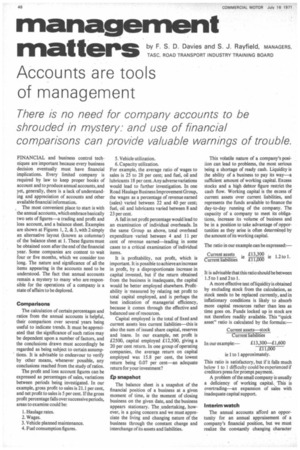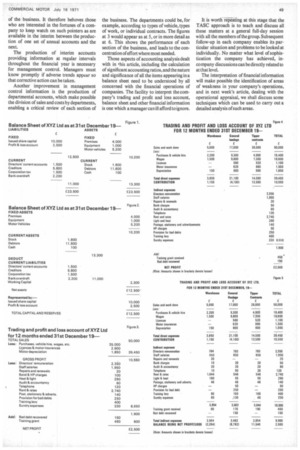management matters
Page 50

Page 51

If you've noticed an error in this article please click here to report it so we can fix it.
by F. S. D. Davies and S. J. Rayfield, MANAGERS, TASC, ROAD TRANSPORT INDUSTRY TRAINING BOARD
Accounts are tools of management
There is no need for company accounts to be shrouded in mystery: and use of financial comparisons can provide valuable warnings of trouble.
FINANCIAL and business control techniques are important because every business decision eventually must have financial implications. Every limited company is required by law to keep proper books of account and to produce annual accounts and yet, generally, there is a lack of understanding and appreciation of accounts and other available financial information.
The most convenient place to start is with the annual accounts, which embrace basically two sets of figures—a trading and profit and loss account, and a balance sheet. Examples are shown at Figures 1, 2, & 3, with 2 simply an alternative layout (known as columnar) of the balance sheet at I. These figures must be obtained soon after the end of the financial year. Some companies are content to wait four or five months, which we consider too long. The nature and significance of all the items appearing in the accounts need to be understood. The fact that annual accounts remain a mystery to many who are responsible for the operations of a company is a state of affairs to be deplored.
Comparisons The calculation of certain percentages and ratios from the annual accounts is helpful, their comparison over several years being useful to indicate trends. It must be appreciated that the significance of such ratios may be dependent upon a number of factors, and the conclusions drawn must accordingly be regarded as being subject to certain assumptions. It is advisable to endeavour to verify by other means, whenever possible, any conclusions reached from the study of ratios.
The profit and loss account figures can be expressed as percentages of sales, variations between periods being investigated. In our example, gross profit to sales is 21.1 percent, and net profit to sales is 5 per cent. If the gross profit percentage falls over successive periods, areas to examine could be: 1. Haulage rates.
2. Wages.
3. Vehicle planned maintenance.
4. Fuel consumption figures. 5. Vehicle utilization.
6. Capacity utilization.
For example, the average ratio of wages to sales is 25 to 28 per cent; and fuel, oil and lubricants 18 per cent. Any adverse variations would lead to further investigation. In one Road Haulage Business Improvement Group, the wages as a percentage of revenue earned (sales) varied between 22 and 40 per cent; fuel, oil and lubricants varied between 8 and 23 per cent.
A fall in net profit percentage would lead to an examination of individual overheads. In the same Group as above, total overhead expenditure • varied between 4 and 11 per cent of revenue earned—leading in some cases to a critical examination of individual items.
It is profitability, not profit, which is important. It is possible to achieve an increase in profit, by a disproportionate increase in capital invested, but if the return obtained from the business is inadequate, the capital would be better employed elsewhere. Profitability is measured by relating net profit to total capital employed, and is perhaps the best indication of managerial efficiency, because it comes through the effective and balanced use of resources.
Capital employed is the total of fixed and current assets less current liabilities—this is also the sum of issued share capital, reserves and loans. In our example, net profit is £2500, capital employed £12,500, giving a 20 per cent return. In one group of operating companies, the average return on capital employed was 15.8 per cent, the lowest return being 0.07 per cent—an adequate return for your investment?
fp snapshot The balance sheet is a snapshot of the financial position of a business at a given moment of time, ie the moment of closing business on the given date, and the business appears stationary. The , undertaking, however, is a going concern and we must appreciate the living and changing nature of the business through the constant change and interchange of its assets and liabilities. This volatile nature of a company's position can lead to problems, the most serious being a shortage of ready cash. Liquidity is the ability of a business to pay its way—a sufficient amount of working capital. Excess stocks and a high debtor figure restrict the cash flow. Working capital is the excess of current assets over current liabilities, and represents the funds available to finance the day-to-day running of the company. The capacity of a company to meet its obligations, increase its volume of business and be in a position to take advantage of opportunities as they arise is often determined by the amount of its working capital.
The ratio in our example can be expressed:—
It is advisable that this ratio should be between 1.5 to land 2 to 1.
A more effective test ofliquiclity is obtained by excluding stock from the calculation, as stock needs to be replaced currently, and in inflationary conditions is likely to absorb more capital resources rather than less as time goes on. Funds locked up in stock are not therefore readily available. This "quick asset" ratio is calculated by the formula:— Current assets—stock Current liabilities
In our example:— £13,300—1,600 £11,000 ie Ito 1 approximately.
This ratio is satisfactory, but if it falls much below Ito 1 diffi culty could be ex peri en ced if creditors press for prompt payment.
A problem of the small company is usually a deficiency of working capital., This is overtrailing—an expansion of sales with inadequate capital support.
Interim watch The annual accounts afford an opportunity for an annual appraisement of a company's financial position, but we must realize the constantly changing character
of the business. It therefore behoves those who are interested in the fortunes of a company to keep watch on such pointers as are available in the interim between the production of one set of annual accounts and the next.
The production of interim accounts providing information at regular intervals throughout the financial year is necessary for management control. Managers must know promptly if adverse trends appear so that corrective action can be taken.
Another improvement in management control information is the production of departmental accounts, which make possible the division of sales and costs by departments, enabling a critical review of each section of the business. The departments could be, for example, according to types of vehicle, types of work, or individual contracts. The figures at 3 would appear as at 5, or in more detail as at 6. This shows the performance of each section of the business, and leads to the concentration of effort where most needed.
Those aspects of accounting analysis dealt with in this article, including the calculation of significant accounting ratios, and the nature and significance of all the items appearing in a balance sheet need to be understood by all concerned with the financial operations of companies. The facility to interpret the company's trading and profit and loss account, balance sheet and other financial information is one which a manager can ill afford to ignore.
It is worth re-Peating at this stage that the TASC approach is to teach and discuss all these matters at a general full-day session with all the members of the group. Subsequent follow-up in each company enables its particular situation and problems to be looked at individually. No matter what level of sophistication the company has achieved, incompany discussions can be directly related to at that level.
The interpretation of financial information will make possible the identification of areas of weakness in your company's operations, and in next week's article, dealing with the operational appraisal, we shall discuss some techniques which can be used to carry out a detailed analysis of such areas.




























































































